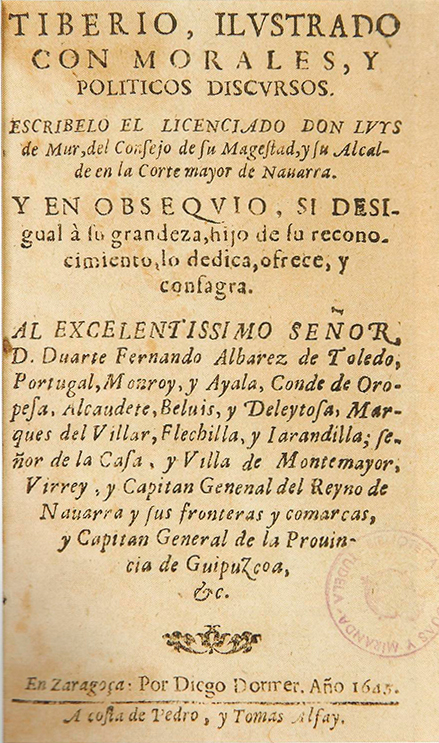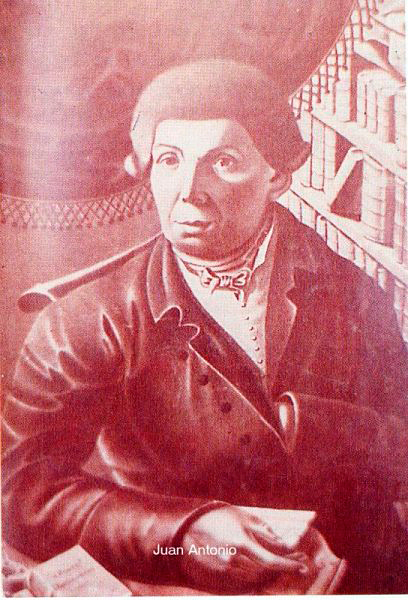24 August
lecture series
FOUR PERSPECTIVES ON THE CULTURAL HERITAGE OF TUDELA
Serving the small homeland: four characters in the Modern Age
D. Esteban Orta Rubio
Full Professor retired from high school
Among the illustrious characters that populate the history of Tudela during the Modern Age, some achieved honor and recognition, but others, in spite of having enlarged the cultural patrimony of their small homeland, fell into oblivion. This is the case of two men and two women whose lives took place between two dates core topic: 1598, death of Philip II, and 1814 with the end of the War of Independence and the beginning of the reign of Ferdinand VII.
Luis de Mur y Navarro (1598-1650)
Unjustly forgotten in spite of his multifaceted personality that included both the political life and the literary aspect. His name does not appear in the History of Navarre Literature nor does he have a entrance in the Great Encyclopedia of Navarre. Only, Javier Velaza, Un humanista del siglo XVII en Navarra: Luis de Mur, and Esteban Orta, Luis de Mur. Jurist, writer and politician, have approached the character.
Belonging to a noble family from Tudela, he studied law at the University of Huesca and successfully practiced law. First in Tudela as a lawyer for the City Council and the Cabildo. Subsequently, as a jurist in the Courts of Navarre until ascending to positions in the committee of the Kingdom and mayor in the High Court of Navarre. Nor should we forget the political variant as he attended the Cortes de Navarra, representing the city of Tudela. But perhaps the facet that gave him more prestige in his time were the legacys as interlocutor between Navarre and the central power during the convulsive years of the crisis of 1640. The letters in which he recounts his travels and interviews with Olivares and Felipe IV provide interesting data .
On the other hand, his literary work as a writer, poet and essayist is extensive. Two books stand out: Triumphs of slavery, virtues of Moysen and hardness of Pharaoh (1640) and Tiberius, illustrated with moral and political speeches (1645). Both works belong to the genre of the political essay , very much in vogue at the time. They are based on the life of antique characters, and censure or praise their behavior, with veiled allusions to the political life of the time. For Professor Velaza, he is "undoubtedly the political thinker of the 17th century with the greatest influence in the region and indispensable among the Hispanic tacitists".

Plate 1. Luis de Mur, Tiberius, illustrated with moral and political speeches.
Away from political life due to health problems, he died in Pamplona in the fall of 1650. He was buried in the church of the Dominicans of Tudela, where the Mur family had a funeral chapel.
Isabel Virto y Luna (1663 - 1750)
A special woman who knew how to move for decades in a mostly male sphere, as a businesswoman and owner of an important bullfighting ranch. In the words of the historian of bullfighting in Navarra, Ramón I. Villanueva: "She has gone down in the history of bullfighting as the most important of the Navarrese bull breeders of the 18th century".
She was born in Corella in 1663 in the bosom of influential families. She married very young with Jerónimo de Aibar and, after being widowed, she married again in 1695 with Antonio Lecumberri, from Tudela, owner of an important cattle ranch, whose house with gate and coat of arms still stands in Serralta Street. The marriage did not last long because Lecumberri died in 1709, leaving her a widow with many children, some of them young. Isabel Virto -she was already 45 years old- had to face family and business, being the strong woman that the bible speaks of. For almost forty years she remained at the head of the bullfighting business, which went through difficult phases (such as the War of Succession) and others of great prosperity. The bulls of the Widow of Lecumberri -that was the name of the ranching- were in great demand in bullrings in Navarre and the Basque Country: Tudela, Estella, Pamplona, Bilbao, Guipúzcoa, even reaching Madrid. The death in 1734 of his son Pedro Lecumberri Virto, was a hard blow but he recovered and continued until he was 83 years old when he donated the cattle ranch to his grandchildren. He died in 1750 at a very advanced age for the time; so much so that the death certificate states "Aged 96 years, a little more or less", although he was really 87.
A granddaughter of his sold the cattle ranch to Francisco Javier Guenduláin and later, in the 19th century, it passed to Nazario Carriquiri.
María Ignacia Sartolo Colmenares (1706 - 1766)
Nun from Tudela, dedicated to the Education of girls and founder of the high school de la teaching in Mexico City. Her paternal branch, the Sartolo family, came from France. Settled in Tudela, they based their power on commerce and cattle raising. The Colmenares, from Pamplona, were lawyers and notaries.
She entered very young in the convent of the teaching of Tudela, founded a short time before, where she reached important positions and where she established knowledge with Sister María Ignacia Azlor, a rich Mexican Creole, who dedicated her energies and ample patrimony to found a new convent in Mexico City. After overcoming many difficulties, the expedition of eleven nuns left Tudela in October 1752, among them were Maria Ignacia Azlor and Maria Ignacia Sartolo. The latter, who was already 46 years old, was named superior of the small community that after a very long journey arrived in the Mexican capital in August 1753. With hardly any rest they continued their goal and in November of the following year they inaugurated the high school destined "to Creole and Indian girls, legitimate and illegitimate, rich and poor, of all colors and races". Pilar Foz emphasizes that this was the first school for girls, public and free, to be founded in Mexico; an unprecedented event.
M. Maria Ignazia Sartolo was the soul of project and the first superior. After years of hard educational work, she died in 1766, before she was sixty years old. It did not take long for her great companion, Maria Ignacia Azlor, to join her, for she died a year later, in April 1767.

Plate 2. Church of high school de la teaching. Mexico City.
Juan Antonio Fernández (1752-1814)
Paleographer, archivist, archaeologist and historian. His work, very extensive and still unpublished, has had great influence among those who have investigated the history of Tudela. He was born in 1752 in the plazuela of San Nicolás where his father ran a bookshop and perhaps the contact with books made him fond of old documents until he became, very early, a specialist in reading, ordering and classifying both ecclesiastical and noble archives.

Plate 3. Juan Antonio Fernández
He began at the age of fifteen when the city council entrusted him to put in order the file of the recently suppressed Jesuit convent. This was followed by the archives of the local nobility, especially that of the Marquis of San Adrian, and he ended up as archivist of the new diocese of Tudela. His fame spread outside Navarre and he soon received a tempting offer to order the file of the Order of Santiago, located in Uclés (Cuenca). He remained there for four years (1789-1793), during which time he also took the opportunity to excavate and sketch the remains of ancient Segóbriga. His admirable work earned him the degree scroll of General Archivist of the Order of Santiago. When he returned to Tudela, he was entrusted with a new challenge: to order and catalogue the file General of the Order of St. John of Jerusalem (Zaragoza). A hard work in which he invested many years and in which he was when in January of 1808 he received the news of his appointment as Archivist of the First administrative office of State, in Madrid. Perhaps this honor came too late. In addition, the War of Independence forced him to take refuge in Tudela, where he spent his last years dedicated to the service of his hometown. From 1813 he was part of the first constitutional city council, of which a young Yanguas y Miranda was secretary.
Juan Antonio Fernández, author of numerous works of research, was a member of the Royal Academy of History and maintained contact epistolary with important figures of the time. He died in June 1814, shortly after the end of the war, when Ferdinand VII began his ill-fated reign.
